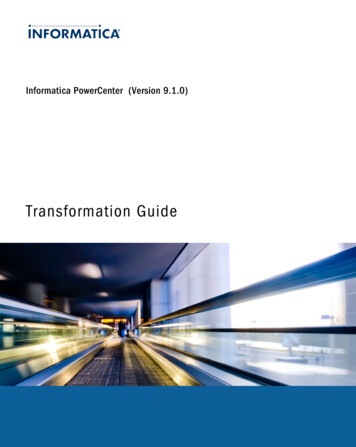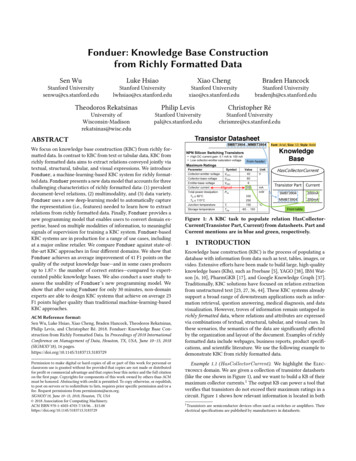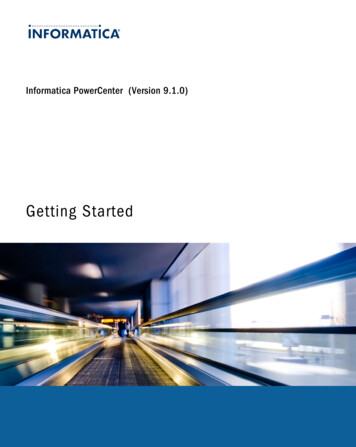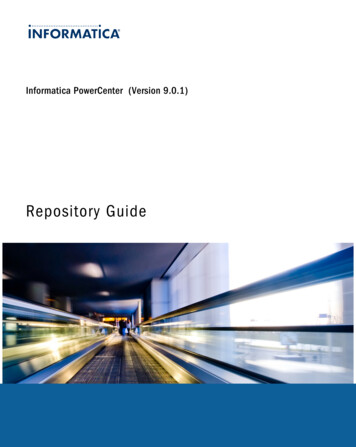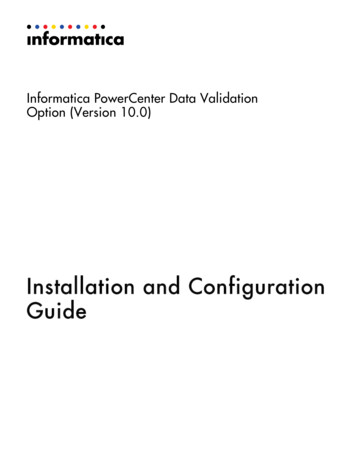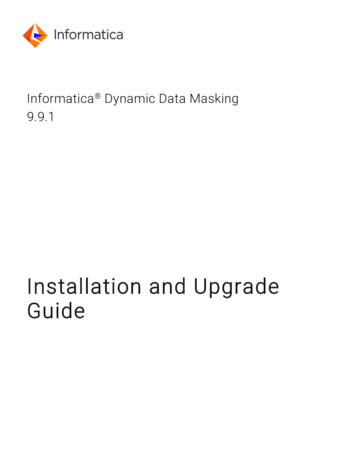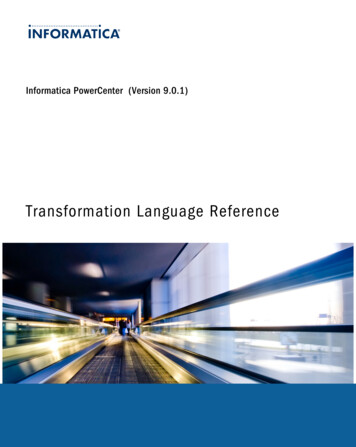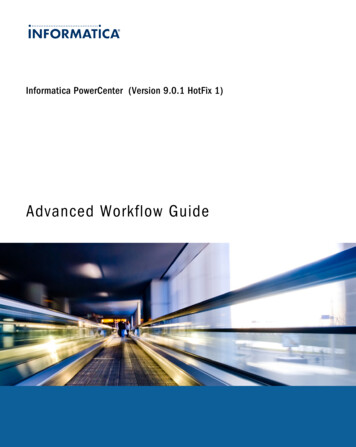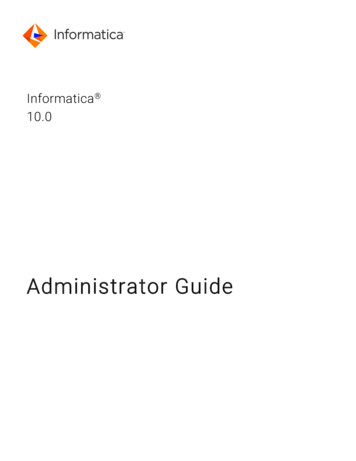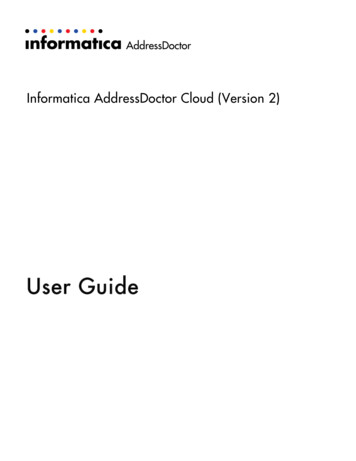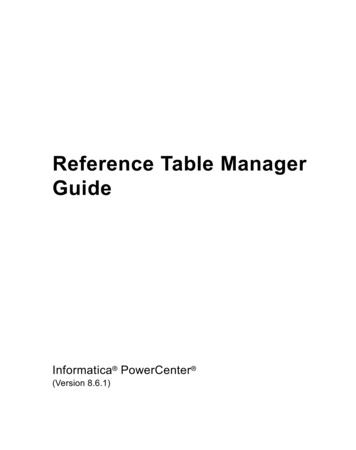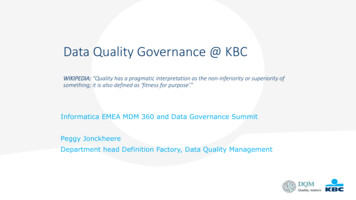
Transcription
Data Quality Governance @ KBCWIKIPEDIA: “Quality has a pragmatic interpretation as the non-inferiority or superiority ofsomething; it is also defined as ‘fitness for purpose’.”Informatica EMEA MDM 360 and Data Governance SummitPeggy JonckheereDepartment head Definition Factory, Data Quality Management
Agenda1. Data Governance – a trend or Buzz-word?2. Data Management Framework3. Data Governance Tool4. Business Glossary versus Data Dictionary5. The road aheadCompany2
1CompanyData Governance – a trend or Buzz-word?3
Data Goverance: a trend?a buzz-word? No Some Background 2013January: BCBS239 expliciting 201414 principles for Risk DataAggregation and ReportingMarch-May: 2nd selfreleased – for G-SIBassessment G-SIBMarch-June: 1st G-SIB selfassessment questionnaireDecember: results of selfassessment in BCBS 268 national supervisors alsoto apply the D-SIBs (3yrsafter designation)2015January-September: AQR1JAN : DQM establishedOctober: AQR findings N 6&7 - BCBS239-likerecommendationsFebruary: ExCo approvalDQM action plan2016July-August: ECB BCBS239Thematic review Phase 1:March: kick-off Data Quality Self AssessmentGovernanceQuestionnaireNovember: KBC GExCodecision regarding dataAugust: ExCo approval Data October-November: ECBquality management and the Management FrameworkBCBCS239 Thematic reviewcreation of a DQMand its implementation plan Phase2: Fire Drill and DataDirectorateLineage New action plan to close furtherthe gaps towards BCBS239
BCBS 239: The Basel Principles for Effective Risk Data Aggregation and Risk ReportingFourteen principles in total – 11 directed to banks, 3 to supervisory bodies Overall governance/infrastructure – 2 principlesRisk data aggregation capabilities – 4 principlesRisk reporting practices – 5 principles ImplicationsDrastic measuresBCBS 239 requires the institution as a whole to extensively review thereporting process, data quality and data infrastructure.Overarching governanceand infrastructureRisk Data AggregationcapabilitiesRisk ReportingPracticesSupervisory practices – 3 principles Board & Senior management responsibilityData ownershipUnified data taxonomiesFully supportive data architecture and infrastructure Accurate and reliableFlexible, ensure possibility to aggregate at different levelsFully documentedManual interventions should be limitedResilient to changeReconciliation on trade levelEvaluating data quality through key quality indicators Data quality must be a board-level issueConvey the right informationComprehensive, clear and usefulIn normal and stress/crisis situationsImproved forward-looking and stress tests capabilities5Principle 13:Supervisors have the ability to use a range of tools: Require immediate action from institution Require independent review (e.g. External Audit) Capital add-on Limit bank’s growth Limit business venture and acquisitionsInstitutions must be prepared to periodicallyprepare progress reports for the supervisors
BCBS 239:Progress in adopting the Principles for effective risk data aggregation and riskreporting, March 2017source : http://www.bis.org/bcbs/publ/d399.pdfKBC Group NV6
2CompanyData Management Framework7
Data Management FrameworkGovernance withfocus on data quality Data Management Framework (DMF) describes the organization, processes and policiesnecessary for achieving and maintaining data quality in a structured and efficient way. The implementation of the Data Management Framework enables all stakeholders in KBC to run their business more effectively provides reliable data in an efficient way creates a single version of the truth by aligning terminology and its use in datacollection and reporting Scope: “All data, group wide, that are used for (external) reporting and can have an ultimateimpact on balance sheet or results” “All data subject to transformation and enrichment processes from the source systemsto the final report.” Approved by KBC Group ExCO on September 1st 20158
DMF: Turning data into a strategic assetThree levels of maturity: Data needs a high quality of supply. This means the timelydelivery of complete and correct data in a controlled way.Data is checked and validated so that it reflects thebusiness reality; Information can only exist if data is accompanied by aDefinition and Ownership is taken up. A Definition sets therequirements for data entry and data processing (accurateimplementation); Insight can be obtained by information deployment withhigh added value including concerns like overview,comprehensiveness, details, presentation, drill down STRATEGIC ASSET!!!!
Definitions Principle 1: All data (both in systems and in reports) have a unique businessdefinition which is available to all stakeholders. Each unique definition has aunique owner.Data LineageDMF: Main principles overview Principle 2: All data have a designated owner who is accountable for the dataquality delivered. Principle 3: At each link in the data delivery chain there is a responsible person forthe quality of the data Principle 4: Data quality is validated independently. Principle 5: Traceability of all data to its source is documented. Principle 6: All data needed for (external) reporting will be included in the DQMinfrastructure and in its quality assurance. Principle 7: Every (external) report must have a DQM Data quality Label which canonly be obtained by applying the principles in this framework.
DMF: Roles Key roles and responsibilities Definition owner Assigned by the Data Governance Council Responsible for the uniqueness of the definition and the functional consistency in the implementation of it. Data owner Assigned by the Data Governance Council Accountable for the quality of a specific data supply chain and/or report(s) Report owner Assigned by Data Owner Responsible for matching the requirements of the report with the definitions used and the selections applied. Implementation owner Assigned by Data Owner Responsible and SPOC for one or more systems and its documentation ensuring the system runs correctly and is implementedcompliant with the definition. Validation owner Assigned by Data Owner Responsible for verifying the quality of the data delivery/report and reporting any data quality issues to the data owner Data Steward Advises/Supports Data Owners, Definition Owners, Report Owners Part of ‘Governance organization’ Decision Power Data Governance Council (DGC)11
DMF: OrganisationDecision layerGROUP EXCOMQQGovernance CouncilSteering layerASC @ localM DQM Sounding BoardSteeringOperational LayerStewardshipCommittee2/QQQASC GFDQM STEERING BOARDMReportingPMO24/7Governance operations DQM OperationsData dict. mgmtData own. mgmtData qual. mgmtClusterPrestudyPrestudyPrestudyPrestudy E2E-ProjectE2E-ProjectE2E-ProjectE2E-Project PrestudyProjectE2E-Project ARCHITECTUREBOARDM
DMF Principle 1: Definitions Principle 1: All data (both in systems and in reports) have a unique business definition which isavailable to all stakeholders. Each unique definition has a unique definition owner. Danger near-same definitions, definitions - content, unnoticed, Unique business definition - unique definition owner for the whole Group Sounding process, involving Subject Matter Experts Approval by Data Governance Council Definitions kept in the Data Governance tool!!! Implementation throughout the KBC Group
2.12 DMF Principles 2, 3 and 4: Data Ownership Principle 2: All data have a designated owner who is responsible and accountable for the data quality delivered. Data Owner a (Senior) General Manager, and is end-responsible and accountable for the quality of the data produced inhis/her entity Data Owner CAN delegate responsibility by appointing Implementation Owners, Validation Owners and in some cases alsoReport Owners. The Data Owner cannot delegate accountability. Principle 3: At each link in the data delivery chain there is a responsible person for the quality of the data. Implementation Owner Recommended: also at intermediate links Principle 4: Data quality is validated independently. The Validation Owner is not the same person as the Implementation Owner. Establishes Data Delivery Agreement (DDA) between two Data OwnersData OwnerImpl. Owner ValidatorEntity 1Data OwnerImpl. OwnerEntity 2ValidatorData OwnerImpl. OwnerValidatorEntity 3Report Owner(Local)Report
2.14 DMF Principle 5Principle 5: Traceability of all data to its source is documented.Every figure in a report must be traceable (data lineage) : Data Governance Tool (Axon)Collaborativetool bringing allthe knowledge ofimplementationand validationowners together
3Data Governance ToolInformatica AxonCompany16
Data Governance Tool Axon is our collaborative Data Governance Tool (DGT) to be used group-wide tosupport the implementation of the Data Management Framework (DMF) Glossary for unique and unequivocal definitions Ownership of definitions and data-flows (roles and responsibilities) Documentation and visualization of data-flows from source system (attributes) till reports(fields)17
Scope Data Governance ToolLink with Definitions:data fields of a systemare linked to DefinitionsDatawarehouse,calculation engine,tactical feed, sourcesystem/applicationSubreportsReport clusterSource system /applicationLineage linking eachdata delivery system tothe nextLineage linking terms of a report toattributes of data delivery systemsLink with Definitions:terms of a report arelinked to DefinitionsREPORT DESCRIPTIONDATA FLOW18
Set-up of Axon In Axon the information is organised in structured lists known as FACETS. Connections between facets are made to illustrate how the data-organisation as a whole links together provide insightData lineage linking each part of thechain to the next.19
Insight maps Maps are a graphical representation of objects found in Axon and the relationships between those objects wherebyUnison Search controls (filters) which objects are included in the map. System lineage Shows systems and the interfaces between them Dataset lineage Displays datasets for which linking attributes are described20
4CompanyBusiness Glossary vs Data Dictionary21
Business Glossary vs Data DictionaryBusiness glossary A business glossary is a repository that contains common definitions of industry terms across thebusiness. These industry terms are the building blocks that are known and used in the business. Meant to be used by business users There is only one business glossary enterprise-wide. The core objective of a business glossary isto improve the understanding of business terminology so communication is more effectivelyacross the enterprise. One of the complexities of communications in the global enterprise is thateach individual can have a different context for the meaning and definition of the terminologyused in the business. In a nutshell, it’s the place where important business terms are clearly owned, articulated andcontextualized.Data dictionary A data dictionary documents the metadata – the data about the data – and how it is used.Typically, data dictionaries are designed to store a limited set of metadata concentrating on thenames and definitions relating to the physical data and related objects. Meant to be used by data users A data dictionary describes the data elements, their meanings, their relationship to other dataelements, their allowable values, . The data element descriptions use the terms defined in thebusiness glossary. This links the data dictionary to the business glossary. There are multiple data dictionaries in the organization, they are more technical in nature andthey are system specific. A data dictionary must be a project deliverable for all system-relatedprojects.ProductPartyBondCovered BondCreditCredit RiskParty IdentifierImpairmentGranted AmountGranted AmountEffective maturity datePSN numberISIN CodeAmount TypeFinancial assets - equity instrumentsthrough profit and loss - measuredat cost @ IFRS22
Business Glossary vs Data DictionaryData Governance FrameworkData DictionariesSystemsEBACOREPFINREPBusiness GlossaryRep ARep a ModelCALCommonDataModelRisk etadata sPF23
5CompanyThe road ahead24
After 2 years of experience and the BCBS239 review by ECB New action plan to close furtherthe gaps towards BCBS239 Establishment of a CDM organisation
After 2 years of experience and the BCBS239 review by ECB New action plan to close furtherthe gaps towards BCBS239Data Governance Framework Start-up of a Definition FactoryData DictionariesFocus ofthe definition factoryEBABusiness GlossaryInternModelLinkCommonData ModelCALPFMetadata Lineage
After 2 years of experience and the BCBS239 review by ECB New action plan to close furtherthe gaps towards BCBS239 Data Management Framework re-visit Architectural project with aim to go to one common platform/solution Removing the data and reporting silos of the Finance, Risk and Treasury Functions
Data Management Framework (DMF) describes the organization, processes and policies necessary for achieving and maintaining data quality in a structured and efficient way. The implementation of the Data Management Framework enables all stakeholders in KBC to run their business more effectively provides reliable data in an efficient way
